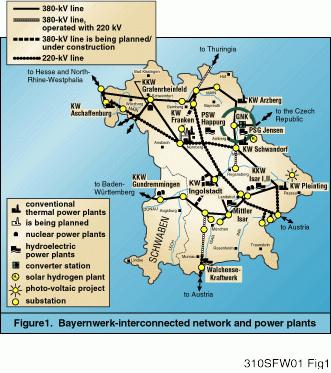
HVDC converter station links European grid
Apr 13, 2010 - Wayne Beaty - powergenworldwide.com
HVDC converter station links European grid
Replacing an inefficient link in Europe positions region to compete in world markets
By Wayne Beaty,
Power Delivery Editor
Political and market changes in Central and Eastern Europe have created major new challenges for the electric power suppliers.
Bayernwerk, one of the leading power utilities in the Federal Republic of Germany, is one of the transregional power utilities that builds and operates conventional and nuclear power plants and a high voltage power grid of about 5,500 km.
Its power generation and distribution in Bavaria is interconnected with other partners in Germany and Europe. The interconnected system is controlled by a modern dispatching centre in Karlsfeld near Munich.
Bayernwerk has a mixture of fuels for its generating plants, including nuclear, fossil and hydro.
Some 70 percent of the power is produced by nuclear and hydroelectric. These plants are especially environmentally acceptable. They do not release NOx, SO2 or CO2 into the atmosphere.
In more recent years, Bayernwerk has also been involved in new markets outside the electric power sector. Its subsidiary, Contigas, is active in the natural gas supply business.
International cooperation required
The modernization of Eastern Europe`s power infrastructure requires international cooperation. The participants are committed to forming an efficient and reliable system so they can compete for the region`s loads--particularly the industrial loads. EuroBayernwerk GmbH, Bayernwerk`s subsidiary responsible for international activities, is playing a major role in the interconnected system. It is available as an equity partner in regional energy projects.
Bavaria and its eastern neighbors have a long-standing tradition of cooperation in energy matters. Since the 1920s, Bohemian mines in Most and Sokolov have been supplying lignite to Bayernwerk. Also, as early as the 1960s, electrical energy was exchanged between Czechoslovakia and Bavaria through Austria.
The route through Austria, however, was not efficient because of excessive transmission losses. The solution was a direct link and this was accomplished with a HVDC back-to-back converter station and a transmission line between Etzenricht in Bavaria and Hradec in Bohemia.
The new system links countries in Eastern Europe and provides for the direct exchange of electric power. The link serves as an example to other power associations in Western and Eastern Europe of what can be done with international cooperation.
The station is not only more efficient (98.6 percent) than the older system but is also environmentally compatible. Maintaining clean air in the Bavarian-Czech border area was an important consideration in building the Etzenricht link.
Now, the heavily polluting power plants in Western Bohemia can reduce its output or shut down completely during a smog alarm. During these times, more power will be supplied with more modern plants equipped with the most advanced environmental technologies.
Linking incompatible systems
Power grids in Western and Eastern Europe cannot be directly linked because of frequency fluctuations in the East of up to 1 Hz. In the West, however, a steady frequency of 50 Hz with deviations of only 0.05 Hz is maintained. The new HVDC station easily links the two systems without problems of frequency fluctuations. Harmful harmonic currents are removed by filter circuits.
Bayernwerk`s back-to-back converter station is Germany`s only link between Western and Eastern Europe. Worldwide, there are more than 40 HVDC stations with a total capacity of 33 GW. Austria has two converter stations linking Western and Eastern Europe. The station in Itaipu, Brazil, transmits 6,300 MW from a remote hydroelectric power plant to Sao Paulo. The line is over 800 km long.
HVDC converter stations are also used to bridge straits. The Cross Channel link between England and France can carry up to 2,000 MW.


|



